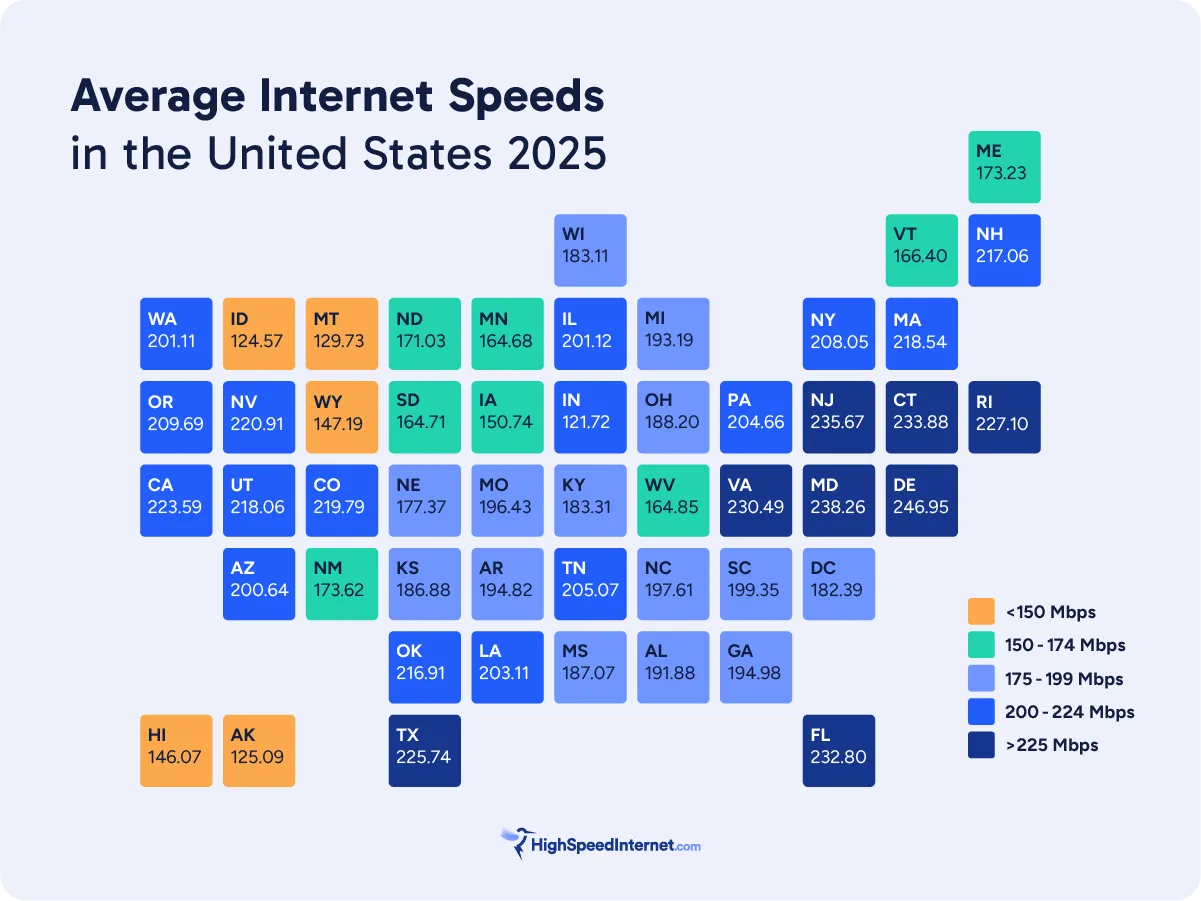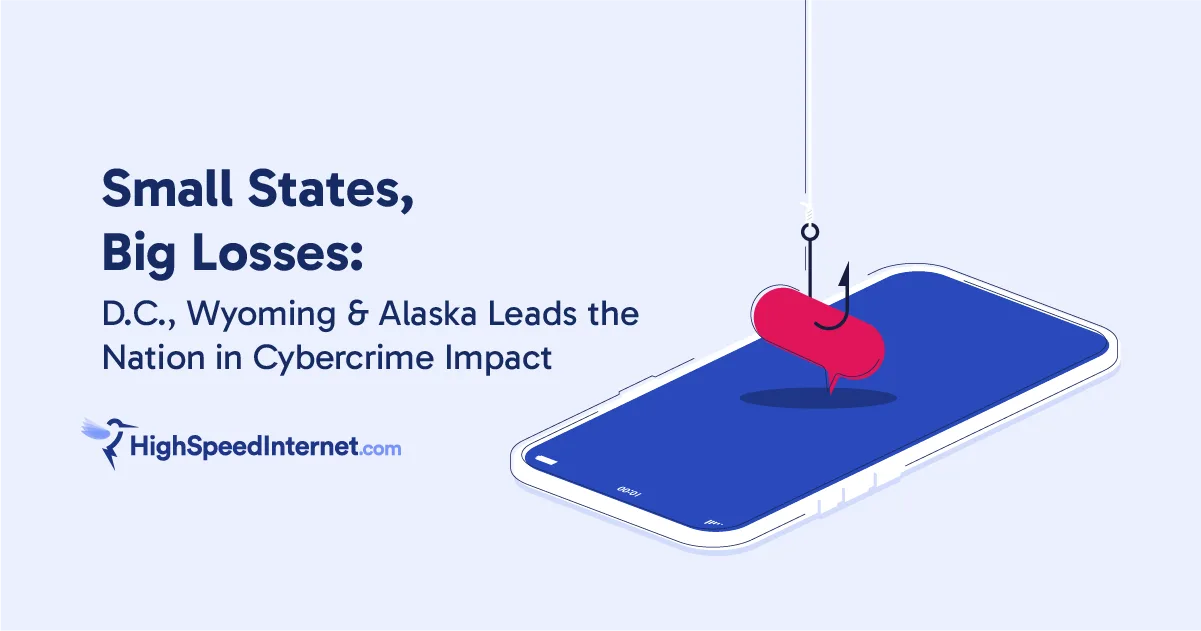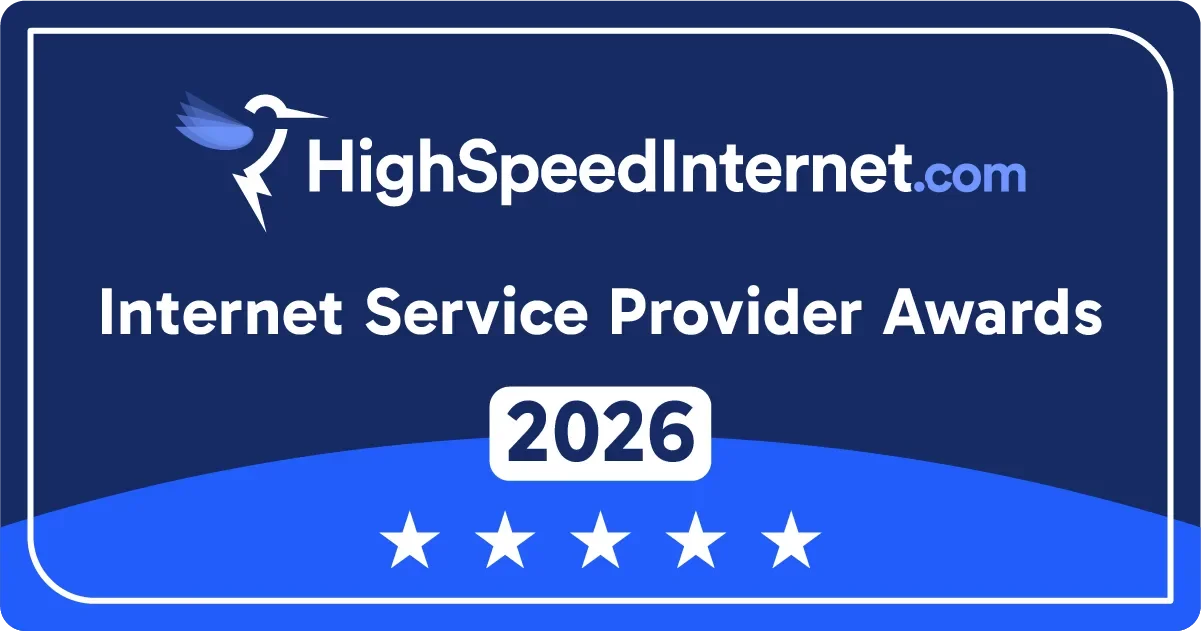2025 Average US Internet Speeds by State
Overall speeds are faster than ever, but rural communities are being left behind
Mar 14, 2025 | Share
Data and Research, Industry Exclusive/Entertainment
HighSpeedInternet.com’s most recent internet speed test data shows the national average internet speed in 2024 was 214Mbps—a 9% year-over-year increase from the previous year’s 196Mbps.
While many Americans now have access to high-speed fiber and 5G broadband, rural areas and underserved communities still fall behind, deepening the digital divide.
Although speeds continue to rise, our Fastest Internet Provider Report shows that the pace of improvement is slowing. Without significant infrastructure advancements and expansion, we could eventually hit a plateau for increasing speeds.
We’ll go over internet speeds across the U.S., highlighting the fastest and slowest states, and examine how these speeds impact everyday activities—from work and school to gaming and streaming. We’ll also discuss the steps being taken to ensure faster internet access in the future.

Internet speeds across America
The average internet speed in the U.S. has reached 214Mbps, reflecting a 9% increase year-over-year from 2023’s 196Mbps.
Several nationwide initiatives, alongside private sector expansion, contributed to these rising speeds and helped bridge the digital divide: The Internet for All program was driving major broadband investments, particularly in underserved areas, while the FCC’s restoration of net neutrality aimed to ensure fairer access and prevent throttling. On top of that, updated broadband benchmarks helped set clearer expectations for internet service providers (ISPs), pushing them to deliver faster and more reliable service.

The fastest internet speeds are found in densely populated coastal states, like Delaware (246.95Mbps), Maryland (238.26Mbps), and New Jersey (235.67Mbps). Strong fiber networks and competition among providers keep speeds high.
Meanwhile, more rural states like Idaho (124.57Mbps), Montana (129.73Mbps), and Alaska (125.09Mbps) get about half the speed due to limited high-speed options and infrastructure.

States with the fastest and slowest internet speeds
To get a clearer picture of national internet access, we ranked states by speed. When compared against the national average, 15 states have speeds above the national average download speeds, and 36 states have speeds below the national average, meaning more states have substandard internet speeds than we could expect, likely due to gaps in access to high-speed broadband networks.
States with the fastest internet speeds
The fastest states for internet in 2025 are largely concentrated in the Northeast and Southeast, where dense infrastructure and major provider investments have driven speeds higher for more people. In fact, 70% of the top-performing states are in these regions.
Setting the new gold standard, these states all have internet download speeds of 220 or more, with Delaware taking the top spot at 246.95 Mbps.

States with the slowest internet speeds
How much do internet speeds vary across the slowest states? At rank 10, Vermont comes in at 166 Mbps, while Idaho—the slowest—comes just 124.57 Mbps, nearly half the average of the fastest states, which reach around 225 to 250 Mbps.

Since broadband expansion is more difficult in rural and mountainous areas, states in the West and Midwest make up most of those with the slowest speeds. Even though demand is lower in these areas, better internet connectivity remains crucial for economic growth, education, and remote work opportunities.
The digital divide: How internet speed varies by region and demographics
High-speed internet access isn’t just about technology—it’s shaped by where you live, what you earn, and the available infrastructure.
Cities with denser populations enjoy faster, more reliable internet thanks to higher demand and more investment from providers. In contrast, remote regions face slower speeds due to the high expansion costs, challenging terrain, and smaller customer bases.
Many lower-income households, even in metro areas, rely on slower, budget-friendly plans—or lack broadband access altogether. Everyday activities, like shopping and online banking, might be lightning quick to accomplish for some but may take others much longer—if they can at all.
The internet speeds you need
For smooth streaming, online gaming, remote work and school, and telehealth, you’ll likely need at least 25Mbps. While many activities don’t require that much speed, it’s important to also consider latency and how bandwidth is shared across multiple devices.
High-performance tasks require more speed than basic activities. For example, HD streaming needs 5 to 10Mbps, but 4K streaming requires 25Mbps or more. Online gaming works best with at least 20Mbps, but a low ping rate is just as crucial. Remote work, school, and telehealth services typically require 10 to 25Mbps. If you want to do multiple of these activities at once, you’ll need even faster speeds to accommodate extra tasks.
When more people and devices are online at once, performance can slow down, especially during peak usage times, compared to the quiet hours of the night when fewer people are online.
Areas with average speeds well above 200Mbps (like California, Colorado, and New Jersey) are more than capable of doing high-demand activities like 4K streaming, online gaming, and remote work regularly with little-to-no trouble.
However, states with lower speeds (such as Idaho, Montana, and Alaska) may struggle with these activities, particularly in rural regions where speeds can be much slower, impacting performance and reliability.
For more information about how much internet speed you need for your regular activities, check out our full guide to internet speed.
Looking ahead: What the US is doing to invest in faster internet speeds
As we discussed in our Fastest ISP Report, as internet demand continues to grow, providers must invest in next-generation technology to boost speeds nationwide.
The rollout of DOCSIS 4.0 brings multi-gigabit speeds to cable internet users, which will improve both download and upload capabilities. Meanwhile, XGS-PON fiber networks show much better acceleration and deployment, expanding access to symmetrical gigabit speeds in urban and suburban areas.
Meanwhile, federal and state broadband initiatives (for example, the BEAD program) are working to close the digital divide by funding broadband expansion to rural and underserved areas.
Conclusion and key takeaways
As internet speeds continue to rise across the U.S., disparities remain between the speedy urban and suburban areas and the slower remote and rural areas. While the national average download speed has reached 214Mbps, driven by fiber expansion and 5G broadband, most states still fall below this benchmark. Coastal states benefit from strong infrastructure and competition, while rural and mountainous regions struggle with slower speeds due to limited broadband access.
Looking ahead, investment in next-gen technologies like DOCSIS 4.0 and XGS-PON fiber will help raise overall speeds. In addition, federal and state initiatives will help expand broadband access to underserved communities, bringing better, more reliable, and faster connections to more Americans.
With these advancements and efforts, 2025 looks to be a transformative year for internet access and performance across the U.S.
Top 10 states with the fastest internet speeds
| Rank | State | Average download speed |
|---|---|---|
| 1 | Delaware | 246.95Mbps |
| 2 | Maryland | 238.26Mbps |
| 3 | New Jersey | 235.67Mbps |
| 4 | Connecticut | 233.88Mbps |
| 5 | Florida | 232.80Mbps |
| 6 | Virginia | 230.49Mbps |
| 7 | Rhode Island | 227.10Mbps |
| 8 | Texas | 225.74Mbps |
| 9 | California | 223.59Mbps |
| 10 | Nevada | 220.91Mbps |
Top 10 states with the slowest internet speeds
| Rank | State | Average download speed |
|---|---|---|
| 1 | Idaho | 124.57 |
| 2 | Alaska | 125.09 |
| 3 | Montana | 129.73 |
| 4 | Hawaii | 146.07 |
| 5 | Wyoming | 147.19 |
| 6 | Iowa | 150.74 |
| 7 | Minnesota | 164.68 |
| 8 | South Dakota | 164.71 |
| 9 | West Virginia | 164.85 |
| 10 | Vermont | 166.40 |
Average internet download speeds of all states
| State | Average download speed | Rank |
|---|---|---|
| Alabama | 191.88 | 31 |
| Alaska | 125.09 | 50 |
| Arizona | 200.64 | 24 |
| Arkansas | 194.82 | 29 |
| California | 223.59 | 9 |
| Colorado | 219.79 | 11 |
| Connecticut | 233.88 | 4 |
| DC | 182.39 | 37 |
| Delaware | 246.95 | 1 |
| Florida | 232.80 | 5 |
| Georgia | 194.98 | 28 |
| Hawaii | 146.07 | 48 |
| Idaho | 124.57 | 51 |
| Illinois | 201.12 | 22 |
| Indiana | 206.46 | 18 |
| Iowa | 150.74 | 46 |
| Kansas | 186.88 | 34 |
| Kentucky | 183.31 | 35 |
| Louisiana | 203.11 | 21 |
| Maine | 173.23 | 40 |
| Maryland | 238.26 | 2 |
| Massachusetts | 218.54 | 12 |
| Michigan | 193.19 | 30 |
| Minnesota | 164.68 | 45 |
| Mississippi | 187.07 | 33 |
| Missouri | 196.43 | 27 |
| Montana | 129.73 | 49 |
| Nebraska | 177.37 | 38 |
| Nevada | 220.91 | 10 |
| New Hampshire | 217.06 | 14 |
| New Jersey | 235.67 | 3 |
| New Mexico | 173.62 | 39 |
| New York | 208.05 | 17 |
| North Carolina | 197.61 | 26 |
| North Dakota | 171.03 | 41 |
| Ohio | 188.20 | 32 |
| Oklahoma | 216.91 | 15 |
| Oregon | 209.69 | 16 |
| Pennsylvania | 204.66 | 20 |
| Rhode Island | 227.10 | 7 |
| South Carolina | 199.35 | 25 |
| South Dakota | 164.71 | 44 |
| Tennessee | 205.07 | 19 |
| Texas | 225.74 | 8 |
| Utah | 218.06 | 13 |
| Vermont | 166.40 | 42 |
| Virginia | 230.49 | 6 |
| Washington | 201.11 | 23 |
| West Virginia | 164.85 | 43 |
| Wisconsin | 183.11 | 36 |
| Wyoming | 147.19 | 47 |
Consult our 2025 methodology for more information about the data we used for this article.
Author -
Trevor's written professionally for five years for editorial publications and retail/e-commerce sites. He lives in Salt Lake City and enjoys photography and making music in his spare time, or you can catch him on your local dance floor bustin' a move.
Editor - Jessica Brooksby
Jessica loves bringing her passion for the written word and her love of tech into one space at HighSpeedInternet.com. She works with the team’s writers to revise strong, user-focused content so every reader can find the tech that works for them. Jessica has a bachelor’s degree in English from Utah Valley University and seven years of creative and editorial experience. Outside of work, she spends her time gaming, reading, painting, and buying an excessive amount of Legend of Zelda merchandise.




